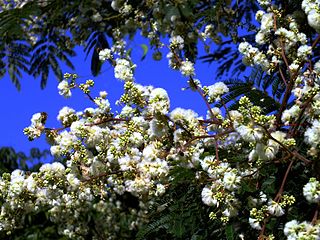
Uncaria] of flowering plants in the family Rubiaceae. It has about 40 species. Their distribution is pantropical, with most species native to tropical Asia, three from Africa and the Mediterranean and two from the neotropics. They are known colloquially as gambier, cat's claw or uña de gato. The latter two names are shared with several other plants. The type species for the genus is Uncaria guianensis.

Sisal, with the botanical name Agave sisalana, is a species of Agave native to southern Mexico but widely cultivated and naturalized in many other countries. It yields a stiff fibre used in making various products. The term sisal may refer either to the plant's common name or the fibre, depending on the context. It is sometimes referred to as "sisal hemp", because for centuries hemp was a major source for fibre, and other fibre sources were named after it.

Senegalia greggii is a species of Senegalia native to the southwestern United States and northern Mexico, from the extreme south of Utah south through southern Nevada, southeast California, Arizona, New Mexico and western Texas to Baja California, Sinaloa and Nuevo León in Mexico.

Catechu is an extract of acacia trees used variously as a food additive, astringent, tannin, and dye. It is extracted from several species of Acacia, but especially Senegalia catechu, by boiling the wood in water and evaporating the resulting brew. It is also known as cutch, black cutch, cachou, cashoo, khoyer, terra Japonica, or Japan earth, and also katha in Hindi, kaath in Marathi, khoyer in Assamese and Bengali, and kachu in Malay.

Vachellia farnesiana, also known as Acacia farnesiana, and previously Mimosa farnesiana, commonly known as sweet acacia, huisache or needle bush, is a species of shrub or small tree in the legume family, Fabaceae. It is deciduous over part of its range, but evergreen in most locales. The species grows to a height of 15–30 feet (4.6–9.1 m) and grows multiple trunks. The base of each leaf is accompanied by a pair of thorns on the branch.

Peumus boldus, the only species in the genus Peumus, is commonly known as boldo. This tree of the family Monimiaceae is natively endemic to the central region of Chile, occurring from 33° to 40° southern latitude. Boldo has also been introduced to Europe and North Africa, though it is not often seen outside botanical gardens.
Uncaria tomentosa is a woody vine found in the tropical jungles of South and Central America. It is known as cat's claw or uña de gato in Spanish because of its claw-shaped thorns. The plant root bark is used in herbalism for a variety of ailments, and is sold as a dietary supplement.
Gato is a Spanish, Portuguese and Galician word for cat.

Acacia concinna is a climbing shrub native to Asia, common in the warm plains of central and south India. The tree is food for the larvae of the butterfly Pantoporia hordonia. Alkaloids are found in the tree's fruit. The species is invasive in New Caledonia.

Martynia is a monotypic genus in the Martyniaceae family consisting of a single species, Martynia annua L., which is commonly known as cat's claw, tiger's claw, or iceplant. However, the name 'iceplant' may also refer to members of the unrelated plant family Aizoaceae.

Acacia confusa is a perennial tree native to South-East Asia. Some common names for it are acacia petit feuille, small Philippine acacia, Formosa acacia and Formosan koa. It grows to a height of 15m. The tree has become very common in many tropical Pacific areas, including Hawaii, where the species is considered invasive.

Zanthoxylum fagara or wild lime, is a species of flowering plant that, despite its name, is not actually in the citrus genus with real limes and other fruit, but is a close cousin in the larger citrus family, Rutaceae. It is native to southern Florida and Texas in the United States, Mexico, Central America, the Caribbean, and South America as far south as Paraguay. Common names include lime prickly-ash, wild lime, colima, uña de gato, and corriosa.

Rhynchophylline is an alkaloid found in certain Uncaria species (Rubiaceae), notably Uncaria rhynchophylla and Uncaria tomentosa. It also occurs in the leaves of Mitragyna speciosa (kratom), a tree native to Thailand. Chemically, it is related to the alkaloid mitragynine.

Traditional Brazilian medicine includes many native South American elements, and imported African ones. It is predominant where indigenous groups and among the black-Native American mestizo population, and in the Northeast coast, nearly all interior regions including Amazon regions, savannahs, rainforest, foothills, and Pantanal. According to Dr. Romulo R. N. Alves, "although Brazil's health system is public...use of traditional remedies and rituals provide an economical way of healing for much of the populace, but that also does not mean that wealthy Brazilians don't seek it out as well. Traditional medicine is a deep part of Brazilian heritage."
Palustris is a Latin word meaning "swampy" or "marshy". It is often used in taxonomy for species names typically in scientific names for animals and plants to refer to the typical habitat of the species.

Uncaria rhynchophylla or the cat's claw herb is a plant species used in traditional Chinese medicine.

Uncaria guianensis, cat's claw, is a plant species in the genus Uncaria found in the Amazon biome. Other names for the plant include uña de gato, Paraguayo and vincaria.

Brazilian tea culture has its origins in the infused beverages, or chás, made by the indigenous cultures of the Amazon region and the Río de la Plata basin. It has evolved since the Portuguese colonial period to include imported varieties and tea-drinking customs. There is a popular belief in Brazil that Brazilians, especially the urban ones, have a greater taste for using sugar in teas than in other cultures, being unused to unsweetened drinks.

Stachytarpheta cayennensis is a species of flowering plant in the verbena family known by many English language common names, including blue snakeweed, Cayenne snakeweed, dark-blue snakeweed, bluetop, nettle-leaf porterweed, rattail, rough-leaf false vervain, blue rat's tail, Brazilian tea, Cayenne vervain, false verbena, joee, nettleleaf velvetberry, and Cayenne porterweed. Names in other languages include honagasō (Japanese), gervão-urticante, piche de gato, rabo de zorro (Spanish), herbe á chenille, herbe bleue, queue de rat (French), ōi, ōwī (Hawaiian), and tiāki (Māori). It is native to the Americas, from Mexico south through Central and South America to Argentina, as well as many islands of the Caribbean. It is known in many other parts of the world as an introduced species, including regions in Africa, India, Indonesia, Australia, Florida in the United States, and many Pacific Islands. Its distribution is now considered pantropical. In many places it has become an invasive species.


















